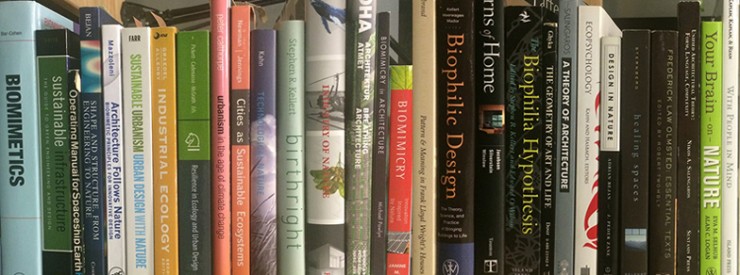

News
Biophilia, Biomimicry & Trends in University Curricula
Catie Ryan
Share
Learn more about our work and services by emailing us at [email protected]. Follow the conversation on twitter: @TerrapinBG.
Recently, I had the pleasure of being a guest speaker for graduate students of Architecture at Judson University in Elgin, Illinois. The lecture is part of a semester-long course on “Biophilia, Biomimicry and Bioculture”, facilitated by architect and professor Robin Randall of Legat Architects. In preparation for the lecture and discussion, students had read “14 Patterns of Biophilic Design” and had prepared a series of questions. We discussed at length popular research areas, low cost interventions, and some of the opportunities and challenges of implementing biophilic design.
Courses like this are indicative of a growing trend in university curricula and programming. Teachings in biophilia and biomimicry are evolving from one-off lectures to instructional courses and even interdisciplinary degree programs. In the United States, UC Berkeley’s Center for the Built Environment and the University of Vermont’s program in Sustainable Design of the Built Environment each have courses on biophilia, and the American Society for Interior Designers (ASID) offers an online continuing education course on the 14 Patterns of Biophilic Design with IDCEC credit. Meanwhile, the Academy of Neuroscience for Architecture is issuing grants to help “promote and advance knowledge that links neuroscience research to a growing understanding of human responses to the built environment;” the University of Virginia’s School of Architecture is home to the Biophilic Cities Network; and Harvard University’s Center for Health and the Global Environment (CHGE) has facilitated projects like the Natural Environments Initiative to advance the research on biophilia.

Nepenthes Pitcher Plant
by Petr Kosina/Flickr
Researchers at Harvard’s Aizenberg Biomineralization and Biomimetics Lab are investigating how the Nepenthes Pitcher Plant, a carniverous plant whose slippery surface makes insects slide down their leaves into their digestive juice, can inspire the development of a non-stick material for meeting the needs of biomedical fluid handling, fuel transport, anti-fouling, optical imaging and other areas.
Harvard was given $125 million to seed the Wyss Institute for Biologically Inspired Engineering, with a mission “to develop biologically inspired materials and devices that will solve critical medical and environmental problems and to translate these transformative technologies into products that have an impact on society and the world.” NYU’s Interactive Telecommunications Program (ITP) has a course that takes a design-based approach to exploring biomimicry as an inspiration for interactive interfaces. The University of Akron Biomimicry Research and Innovation Center is a collaboration with the Greater Lakes Biomimicry regional network and private corporations, who sponsor biomimicry fellowships with tuition waiver and a $20k stipend per year. Georgia Institute of Technology is home to the Center for Biologically Inspired Design, aimed at breaking down the existing boundaries between biology and engineering. Arizona State University now offers a Master of Science in Biomimicry, the first accredited degree program of its kind, and it is already well-received. “Biomimicry has enabled me to connect the dots between design and nature,” says Joe Zazzera, designer and ASU graduate student. “Never again will look at design through the same lens.”
At Judson, the familiar readings of Janine Benyus, Edward O. Wilson, Richard Louv and Terrapin’s own Bill Browning are part of the curriculum. Industry experts Jason McLennan of International Living Future Institute (ILFI), Amy Coffman Phillips of The B-Collaborative, and others have been engaging with the students about biophilia and biomimicry. The toughest question of the discussion was how to respond to naysayers of biophilia and biomimicry. My advice was to understand what’s important to your client — health, stress reduction, creativity, productivity, safety, energy, water, etc. — then give an example of how biophilic design or bioinspired innovation can help solve it. The challenge here is that the library of examples of successful implementation is still quite small, but perhaps with all these hubs for biophilia and biomimicry sprouting up, that will soon change. For biophilia, I would also suggest using a favorite approach of Bill Browning, who encourages all to “Think of your most favorite place to visit… consider whether it’s outside… whether there are trees and water present.” Biophilic design is about taking the science behind why most people will say ‘yes’ to being outside with trees and water, and applying it in design practice.
Biophilia and biomimicry are emerging concepts in design thinking that have managed to capture the interest of audiences worldwide. While the Global Biomimicry Network has 29 regional networks in 17 countries, the Biophilic Cities Network is currently partnering with 14 cities in 7 countries, with hotbeds for research and implementation even more widespread. My hope is that top institutions are able to stay ahead of the curve, help contribute to the growing body of knowledge, and adequately prepare students with the interdisciplinary education necessary to put forth a new generation of industry experts and innovators.
Catie Ryan
Catie is the Director of Projects at Terrapin and a leader in biophilic design movement. With a background in urban green infrastructure, Catie's interest lies in systems thinking to address human health and sustainability challenges at each scale of the built environment.
Topics
- Environmental Values
- Speaking
- LEED
- Terrapin Team
- Phoebe
- Community Development
- Greenbuild
- Technology
- Biophilic Design Interactive
- Catie Ryan
- Spanish
- Hebrew
- French
- Portuguese
- Publications
- Occupant Comfort
- Materials Science
- Conference
- Psychoacoustics
- Education
- Workshop
- Mass Timber
- Transit
- Carbon Strategy
- connection with natural materials
- interior design
- inspirational hero
- biophilia
- economics of biophilia
- Sustainability
- wood
- case studies
- Systems Integration
- Biophilic Design
- Commercial
- Net Zero
- Resorts & Hospitality
- Energy Utilization
- Water Management
- Corporations and Institutions
- Institutional
- Ecosystem Science
- Green Guidelines
- Profitability
- Climate Resiliency
- Health & Wellbeing
- Indoor Environmental Quality
- Building Performance
- Bioinspired Innovation
- Biodiversity
- Residential
- Master Planning
- Architects and Designers
- Developers and Building Owners
- Governments and NGOs
- Urban Design
- Product Development
- Original Research
- Manufacturing
- Industrial Ecology
- Resource Management
- Sustainability Plans
- Health Care
- Carbon Neutrality


